|
Spontin
General.
The village of Spontin is part of the community of Yvoir and is
located in a valley of the Condroz plateau. The village
arose where there is a curve in the flow of the Bocq river, that
debouches a few kilometers downstream into the river Meuse.
Traditionally, agriculture and stone quarries were the most
important industries in the area. A number of these
quarries (most of them in the meantime abandoned) are silent
witnesses of that. There are a few nice sights that give
the village a certain popularity for day trips.
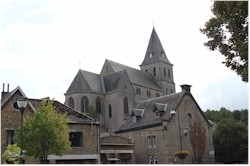 History
in short.
On the spot where the village of Spontin is located, the ancient
Roman roadway between Dinant and Huy used to cross the river.
In order to defend the crossing, a keep was constructed.
Over time, this keep grew into the present castle. In the
12th century, the lordship of Spontin depended on the
neighbouring stronghold of Poilvache. The village was
located in the borderland between the rivalling Prince-bishopric
of Liege and the county of Namur. Due to their rivalry,
there were regularly violent armed clashes. Even when the
county of Namur was incorporated into the duchy of Burgundy, the
confrontations did not cease. There are quite a few
castles, keeps and fortified homesteads in the area that are
testimony to these turbulent times. During the Great War
(1914), the village was almost completely destroyed; a monument
for the fallen has been given a prominent place in the center of
the village (next to the entry of the castle farm). History
in short.
On the spot where the village of Spontin is located, the ancient
Roman roadway between Dinant and Huy used to cross the river.
In order to defend the crossing, a keep was constructed.
Over time, this keep grew into the present castle. In the
12th century, the lordship of Spontin depended on the
neighbouring stronghold of Poilvache. The village was
located in the borderland between the rivalling Prince-bishopric
of Liege and the county of Namur. Due to their rivalry,
there were regularly violent armed clashes. Even when the
county of Namur was incorporated into the duchy of Burgundy, the
confrontations did not cease. There are quite a few
castles, keeps and fortified homesteads in the area that are
testimony to these turbulent times. During the Great War
(1914), the village was almost completely destroyed; a monument
for the fallen has been given a prominent place in the center of
the village (next to the entry of the castle farm).
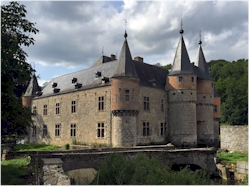 The
castle.
Standing just at the edge of the village, the castle is the
eyecatcher of Spontin. It's built at the right bank of the
small Bocq river, while the village developed on the other side.
The complex consists of the castle itself which is constructed
on a rectangular layout and a fortified farm. The
castle has slender towers and a drawbridge. The moat is
fed by the Bocq river. Right in front of the castle stands
the impressive 17th century fortified farmstead. The
castle evolved from a 12t century keep that was built here to
protect the ancient Roman road. Gradually, the site
expanded but lost it's military importance around the 16th
century. At that moment, the complex was transformed into
a manor. The elegant tower spires and adaptations such as
the characteristic red bricks date back to that time.
Unfortunately, you cannot visit the castle but from the little
park on the opposite bank of the river you have a very nice view
on the chateau. A bit further downstream you can discover
the water mill. The
castle.
Standing just at the edge of the village, the castle is the
eyecatcher of Spontin. It's built at the right bank of the
small Bocq river, while the village developed on the other side.
The complex consists of the castle itself which is constructed
on a rectangular layout and a fortified farm. The
castle has slender towers and a drawbridge. The moat is
fed by the Bocq river. Right in front of the castle stands
the impressive 17th century fortified farmstead. The
castle evolved from a 12t century keep that was built here to
protect the ancient Roman road. Gradually, the site
expanded but lost it's military importance around the 16th
century. At that moment, the complex was transformed into
a manor. The elegant tower spires and adaptations such as
the characteristic red bricks date back to that time.
Unfortunately, you cannot visit the castle but from the little
park on the opposite bank of the river you have a very nice view
on the chateau. A bit further downstream you can discover
the water mill.
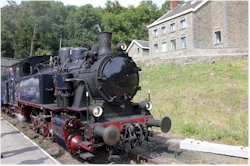 The Bocq
historic railway. The old railway station of
Spontin nowadays is the center of a historic railway. When
the line was abandoned by the national railroads company in
1983, volunteers started a project to revalue the line and to
exploit it again as a railway for historic trains. The
railway runs between Cinay and Purnode and you can board in
different stations, including the one in Spontin. Aboard
historic trainwagons you are taken through tunnels and over
brigdes in the green valley of the Bocq river. It's a very
pleasant family activity and a must-do for amateurs of technique
and trains. The Bocq
historic railway. The old railway station of
Spontin nowadays is the center of a historic railway. When
the line was abandoned by the national railroads company in
1983, volunteers started a project to revalue the line and to
exploit it again as a railway for historic trains. The
railway runs between Cinay and Purnode and you can board in
different stations, including the one in Spontin. Aboard
historic trainwagons you are taken through tunnels and over
brigdes in the green valley of the Bocq river. It's a very
pleasant family activity and a must-do for amateurs of technique
and trains.
The sources
of Spontin.
The natural sources of
Spontin were discovered at the end of the 19th century and
commercialized shortly after that. For longtime they were
very popular and the mineral water was even attributed
healing qualities. Next to mineral and sparkling water, also
sweet sirops were sold. The site of the sources is not
accessible anymore since the exploitation went bankrupt in 2010.
The
geographical center of Wallonia.
A small monument in the
park of Spontin, representing millstones, indicates that the
geographical center of Wallonia is situated in the village.
It's actually not in the center but slightly outside of it (follow
the roadsign).
How
to get to Spontin? This is best done with your own
transport. The E411 highway is closeby.
Links.
- www.yvoir.be: website
of the community of Yvoir (of which Spontin is part)
- www.cfbocq.be: website of
the historic railway "Chemin de fer du Bocq"
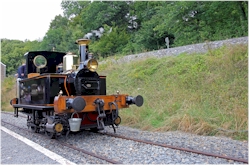
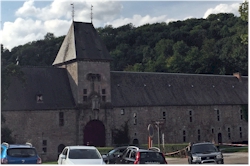
Picture 1: The church of Spontin,
dedicated to Saint-Georges
Picture 2: Spontin castle
Picture 3: Le chemin de fer du Bocq
Picture 4: Yvonne", the oldest still working steam
locomotive constructed in Belgium
Picture 5: The fortified farmstead in front of the castle of Spontin
|
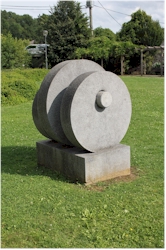
 History
in short.
On the spot where the village of Spontin is located, the ancient
Roman roadway between Dinant and Huy used to cross the river.
In order to defend the crossing, a keep was constructed.
Over time, this keep grew into the present castle. In the
12th century, the lordship of Spontin depended on the
neighbouring stronghold of Poilvache. The village was
located in the borderland between the rivalling Prince-bishopric
of Liege and the county of Namur. Due to their rivalry,
there were regularly violent armed clashes. Even when the
county of Namur was incorporated into the duchy of Burgundy, the
confrontations did not cease. There are quite a few
castles, keeps and fortified homesteads in the area that are
testimony to these turbulent times. During the Great War
(1914), the village was almost completely destroyed; a monument
for the fallen has been given a prominent place in the center of
the village (next to the entry of the castle farm).
History
in short.
On the spot where the village of Spontin is located, the ancient
Roman roadway between Dinant and Huy used to cross the river.
In order to defend the crossing, a keep was constructed.
Over time, this keep grew into the present castle. In the
12th century, the lordship of Spontin depended on the
neighbouring stronghold of Poilvache. The village was
located in the borderland between the rivalling Prince-bishopric
of Liege and the county of Namur. Due to their rivalry,
there were regularly violent armed clashes. Even when the
county of Namur was incorporated into the duchy of Burgundy, the
confrontations did not cease. There are quite a few
castles, keeps and fortified homesteads in the area that are
testimony to these turbulent times. During the Great War
(1914), the village was almost completely destroyed; a monument
for the fallen has been given a prominent place in the center of
the village (next to the entry of the castle farm). 


